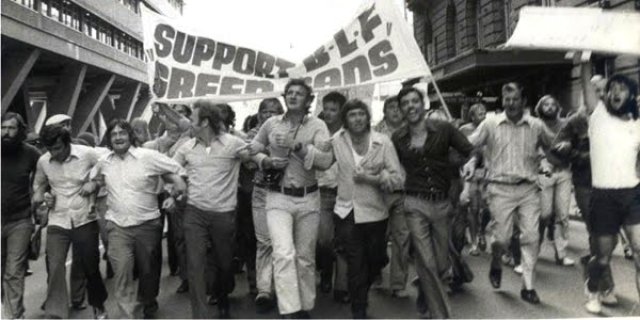
Green Bans, Red Union: The Saving of a City — revised edition
By Meredith & Verity Burgmann
NewSouth, 2017
320pp, pb
$39.99
In the early 1970s, an unlikely alliance of builders labourers, environmentalists, residents and LGBTIQ activists united to support the Green (and Pink) bans which helped save huge swathes of Sydney, and other parts of New South Wales, from the wrecking ball.
The story of these inspired events is well told by Meredith and Verity Burgmann in Green Bans, Red Union, of which a revised edition featuring a new introduction has recently been released.
As well as being a chronicle of the NSW Builders Labourers Federation (BLF), the book is a story of working-class power and social transformation.
The green bans story starts in the 1960s when Sydney was being transformed by a huge building boom pushed along by the Liberal Premier Bob Askin.
Askin’s “paper bag” style of doing business saw historical sites, working-class neighbourhoods, parklands and native bush turned into opportunities for a quick profit.
The building workers who did the lifting, carrying, digging, cleaning up, rigging, scaffolding and crane driving, however, hardly benefitted from the boom.
As younger builders labourers entered the industry, they saw the need for a better deal and began to win control of their union.
The new leaders who emerged, influenced by communist and socialist ideas and 1960s radicalism, favoured a style of unionism based on workplace democracy, job safety, better wages and conditions and a sense of pride in themselves.
Typified by people such as Jack Mundey, Joe Owens and Bob Pringle, the builders labourers were open to wider notions of unionism.
They could see working-class housing, in some case their own homes, being demolished to make way for concrete and glass towers. These often lay unoccupied and unused, while their own suburbs lacked schools and hospitals.
As Mundey, who was elected NSW BLF secretary in 1968, noted: “It is no point in winning great wages and conditions if the world we build chokes us to death.”
This attitude meant that BLF workers listened patiently when a group of “society” women from well-off Hunters Hill approached them for help to save a rare piece of undeveloped harbourside land called Kelly’s Bush.
After the women organised a powerful mass residents meeting and showed that they could stand up against powerful politicians and developers, the BLF banned the use of union labour on any development at Kelly’s Bush.
After the saving of Kelly’s Bush, the BLF was soon inundated with similar requests.
Operating on the principle that BLF support was conditional on proven merit and community involvement, the green bans soon tied up billions of dollars of development projects in Sydney and in non-metropolitan areas such as Newcastle East.
The movement captured the imagination of residents, urban planners, environmentalists and heritage activists. Such bans soon extended to express solidarity with the right of women to work in the industry, anti-freeways campaigns and Aboriginal activists. In 1973, the BLF imposed a “pink ban” when Macquarie University discriminated against a gay student.
The militant BLF was eventually defeated by an alliance between less militant unions, the Master Builders Association and the government. However, the green bans allowed legislation and urban planning to at least partially catch up with new community attitudes to urban development.
Green Bans, Red Union helps activists to catch a glimpse of how working people can be won to a class-struggle vision of society which combines both self-interest and selflessness.
The battle with developers and politicians has never gone away, as they keep looking for ways to privatise parkland, evict tenants, and encroach on heritage areas with their glass and concrete towers.
The fact that a good part of Australia’s cultural and historic heritage was saved by building industry workers does not sit well with the ceaseless employer and government attacks on unions such as the CFMEU.
The book lays bare the fact that capitalism is inherently incompatible with community and the environment.
[Steve O’Brien is a Socialist Alliance member and Newcastle East resident who is part of the campaign against the Supercars race threatening the areas’ heritage precinct and parklands.]
Like the article? Subscribe to Green Left now! You can also like us on Facebook and follow us on Twitter.